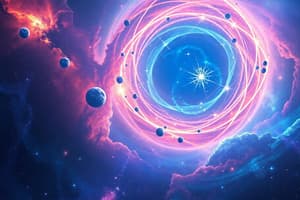Podcast
Questions and Answers
What is a theory?
What is a theory?
- A fact that everyone agrees upon
- An explanation that ties together many observations and hypotheses (correct)
- A guess about scientific laws
- A statement that is always true
What does the Big Bang Theory state?
What does the Big Bang Theory state?
The universe began with a tremendous explosion 13.7 billion years ago.
What is redshift?
What is redshift?
When looking at an object that is moving away, the wavelengths shift to the red end of the spectrum.
What is cosmic background radiation?
What is cosmic background radiation?
What is Hubble's Law?
What is Hubble's Law?
What evidence supports the Big Bang Theory?
What evidence supports the Big Bang Theory?
What information can be obtained from the COBE satellite?
What information can be obtained from the COBE satellite?
How does the Big Bang Theory explain the formation of the Universe?
How does the Big Bang Theory explain the formation of the Universe?
What does the presence of redshift in galaxies indicate?
What does the presence of redshift in galaxies indicate?
What does cosmic background radiation represent?
What does cosmic background radiation represent?
What does Hubble's Law tell us about the universe?
What does Hubble's Law tell us about the universe?
Flashcards are hidden until you start studying
Study Notes
Theory
- An explanation that connects various observations and hypotheses.
- Hypotheses undergo testing over time, gathering evidence to support the overarching theory.
Big Bang Theory
- Proposes the universe originated from a massive explosion approximately 13.7 billion years ago.
Redshift
- Occurs when observing an object moving away, resulting in wavelengths shifting towards the red end of the spectrum.
- Indicative of the universe's expansion, as most galaxies exhibit redshift.
Cosmic Background Radiation
- Represents residual energy from the initial moments of the Big Bang.
- Predicted temperature falls within the microwave range of the electromagnetic spectrum.
Hubble's Law
- Indicates a direct correlation between a galaxy's distance and its velocity.
- Galaxies located farther away are observed to be moving more rapidly.
Evidence Supporting the Big Bang Theory
- Sequence in universe formation includes singularity, explosion, expansion, randomness, building blocks, stars, galaxies, and ongoing expansion.
- Evidence for the theory encompasses redshift, Hubble's Law, and cosmic background radiation.
COBE Satellite
- The Cosmic Background Explorer (COBE) satellite is dedicated to studying cosmology.
- It provided crucial information regarding cosmic background radiation.
Relation of Theory and Big Bang Theory
- The Big Bang Theory details how the universe formed using redshift, Hubble's Law, and cosmic background radiation as supporting evidence.
Relation of Redshift
- Majority of galaxies display redshift, reinforcing the understanding that the universe is expanding.
- This observation aligns with the Big Bang Theory's predictions.
Relation of Cosmic Background Radiation
- Background energy is considered leftover energy from the Big Bang explosion.
- As the universe expanded, this residual energy shifted to lower energy wavelengths.
Relation of Hubble's Law
- Hubble's Law reinforces both redshift and the concept of an expanding universe.
- By reversing current distances and speeds, matter converges back to a singular starting point, known as the singularity.
Studying That Suits You
Use AI to generate personalized quizzes and flashcards to suit your learning preferences.




